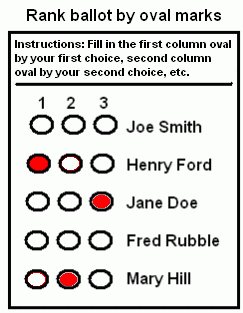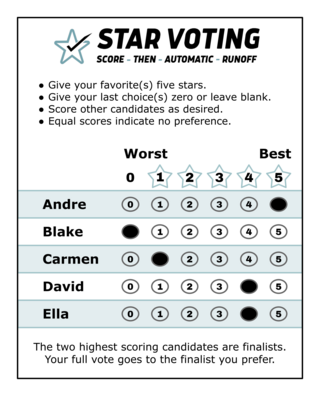Score voting, sometimes called range voting, is an electoral system for single-seat elections. Voters give each candidate a numerical score, and the candidate with the highest average score is elected. Score voting includes the well-known approval voting, but also lets voters give partial (in-between) approval ratings to candidates.
In social choice theory and politics, the spoiler effect refers to a situation where the entry of a losing candidate affects the results of an election. A voting system that is not affected by spoilers satisfies independence of irrelevant alternatives or independence of spoilers.

A Condorcet method is an election method that elects the candidate who wins a majority of the vote in every head-to-head election against each of the other candidates, whenever there is such a candidate. A candidate with this property, the pairwise champion or beats-all winner, is formally called the Condorcet winner. The head-to-head elections need not be done separately; a voter's choice within any given pair can be determined from the ranking.
Coombs' method or the Coombs rule is a ranked voting system, created by Clyde Coombs, which uses a ballot counting method for ranked voting. Coombs' method can be thought of as a cross between instant-runoff voting and anti-plurality voting.
In an election, a candidate is called a Condorcet, beats-all, or majority-rule winner if a majority of voters would support them in a race against any other candidate. Such a candidate is also called an undefeated or tournament champion. Voting systems where a majority-rule winner will always win the election are said to satisfy the majority-rule principle, also known as the Condorcet criterion. Condorcet voting methods extend majority rule to elections with more than one candidate.
The participation criterion, also called vote or population monotonicity, is a voting system criterion that says that a candidate should never lose an election because they have "too much support." It says that adding voters who support A over B should not cause A to lose the election to B.
The Borda count electoral system can be combined with an instant-runoff procedure to create hybrid election methods that are called Nanson method and Baldwin method. Both methods are designed to satisfy the Condorcet criterion, and allow for incomplete ballots and equal rankings.
Reversal symmetry is a voting system criterion which requires that if candidate A is the unique winner, and each voter's individual preferences are inverted, then A must not be elected. Methods that satisfy reversal symmetry include Borda count, ranked pairs, Kemeny–Young method, and Schulze method. Methods that fail include Bucklin voting, instant-runoff voting and Condorcet methods that fail the Condorcet loser criterion such as Minimax.
Later-no-harm is a property of some ranked-choice voting systems, first described by Douglas Woodall. In later-no-harm systems, increasing the rating or rank of a candidate ranked below the winner of an election cannot cause this higher-ranked candidate to lose.
In voting systems theory, the independence of clones criterion measures an election method's robustness to strategic nomination. Nicolaus Tideman was the first to formulate this criterion, which states that the winner must not change due to the addition of a non-winning candidate who is similar to a candidate already present. It is a relative criterion: it states how changing an election should or shouldn't affect the outcome.
Schulze STV is a draft single transferable vote (STV) ranked voting system designed to achieve proportional representation. It was invented by Markus Schulze, who developed the Schulze method for resolving ties using a Condorcet method. Schulze STV is similar to CPO-STV in that it compares possible winning candidate pairs and selects the Condorcet winner. It is not used in parliamentary elections.
Instant-runoff voting (IRV), also known as plurality with elimination or plurality loser, is a ranked-choice voting system that modifies plurality by repeatedly eliminating the last-place finisher until only one candidate is left. In the United Kingdom, it is generally called the alternative vote (AV). In the United States, IRV is often conflated with ranked-choice voting (RCV); however, this conflation is not completely standard, and social choice theorists tend to prefer more explicit terms.

The 2009 Burlington mayoral election was held in March 2009 for the city of Burlington, Vermont. This was the second mayoral election since the city's 2005 change to instant-runoff voting (IRV), after the 2006 mayoral election. In the 2009 election, incumbent Burlington mayor won reelection as a member of the Vermont Progressive Party, defeating Kurt Wright in the final round with 48% of the vote.

An electoral system or voting system is a set of rules that determine how elections and referendums are conducted and how their results are determined. Electoral systems are used in politics to elect governments, while non-political elections may take place in business, non-profit organisations and informal organisations. These rules govern all aspects of the voting process: when elections occur, who is allowed to vote, who can stand as a candidate, how ballots are marked and cast, how the ballots are counted, how votes translate into the election outcome, limits on campaign spending, and other factors that can affect the result. Political electoral systems are defined by constitutions and electoral laws, are typically conducted by election commissions, and can use multiple types of elections for different offices.

The term ranked voting, also known as preferential voting or ranked-choice voting, pertains to any voting system where voters indicate a rank to order candidates or options—in a sequence from first, second, third, and onwards—on their ballots. Ranked voting systems vary based on the ballot marking process, how preferences are tabulated and counted, the number of seats available for election, and whether voters are allowed to rank candidates equally.
The later-no-help criterion is a voting system criterion formulated by Douglas Woodall. The criterion is satisfied if, in any election, a voter giving an additional ranking or positive rating to a less-preferred candidate can not cause a more-preferred candidate to win. Voting systems that fail the later-no-help criterion are vulnerable to the tactical voting strategy called mischief voting, which can deny victory to a sincere Condorcet winner.
A major branch of social choice theory is devoted to the comparison of electoral systems, otherwise known as social choice functions. Viewed from the perspective of political science, electoral systems are rules for conducting elections and determining winners from the ballots cast. From the perspective of economics, mathematics, and philosophy, a social choice function is a mathematical function that determines how a society should make choices, given a collection of individual preferences.

STAR voting is an electoral system for single-seat elections. The name stands for "Score then Automatic Runoff", referring to the fact that this system is a combination of score voting, to pick two finalists with the highest total scores, followed by an "automatic runoff" in which the finalist who is preferred on more ballots wins. It is a type of cardinal voting electoral system.
The sincere favorite or no favorite-betrayal criterion is a property of some voting systems, that says voters should have no incentive to vote for someone else over their favorite. It protects voters from having to engage in a kind of strategy called lesser evil voting or decapitation.
A top-four primary or top-four ranked-choice voting is an election method using a nonpartisan blanket primary where up to four candidates, those with the most votes, advance from a first round of FPTP voting, regardless of the political party. The round two (general) election, held some weeks later, uses instant-runoff voting to confirm a winner among the top set of candidates.






